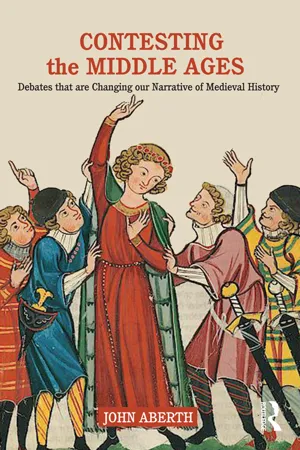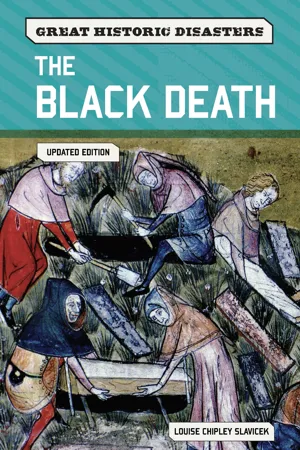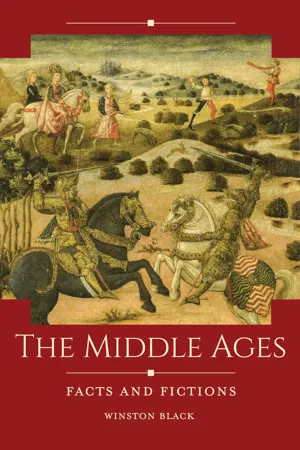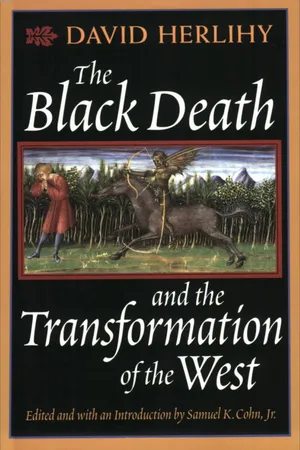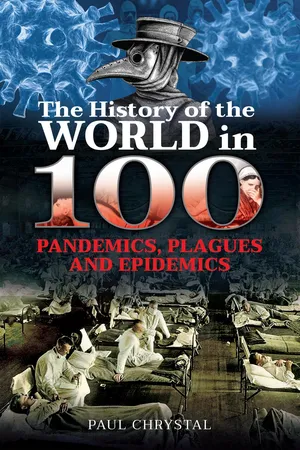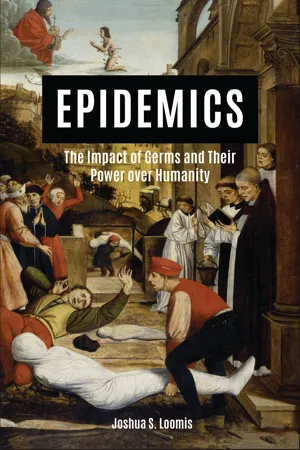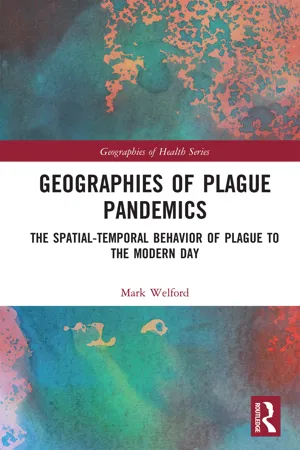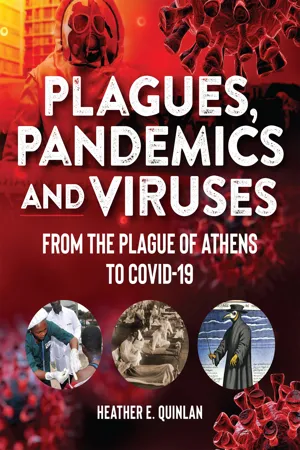History
The Black Plague
The Black Plague, also known as the Black Death, was a devastating pandemic that swept through Europe in the 14th century, resulting in the deaths of an estimated 25 million people. It was caused by the bacterium Yersinia pestis, which was transmitted through fleas infesting rats. The Black Plague had profound social, economic, and cultural impacts on medieval Europe.
Written by Perlego with AI-assistance
Related key terms
Related key terms
1 of 4
Related key terms
1 of 3
12 Key excerpts on "The Black Plague"
- eBook - ePub
- Irwin W. Sherman(Author)
- 2017(Publication Date)
- ASM Press(Publisher)
4 An Ancient Plague, the Black DeathFigure 4.1 The Plague by Felix Jenewein (1900) shows a mother carrying a coffin with her child (Courtesy Wellcome Library, London, CC-BY 4.0)During the last 2,500 years, three great plague pandemics have resulted in social and economic upheavals unmatched by armed conflicts or any other infectious disease. In Constantinople, the capital of the Roman Empire in the East, it was the first plague pandemic (A.D. 542-543) that surely contributed to Justinian’s failure to restore imperial unity. In the year 1346 the second pandemic began, and by the time it disappeared in 1353, the population of Europe and the Middle East had been reduced from 100 million to 80 million people (Fig. 4.1 ). This devastating pandemic, known as the Black Death, the Great Dying, or the Great Pestilence, put an end to the rise in the human population that had begun in 5000 B.C., and it took more than 150 years for the population to return to its former size. Some believe this catastrophic crash in population to be Malthus’s prophecy come true, while others, such as the historian David Herlihy, consider the Black Death to be not a catastrophe promoted by “positive checks” (i.e., disease, war, and famine) but an exogenous factor that served to break a Malthusian stalemate. That is, despite fluctuations in population size, relatively stable population levels were maintained over prolonged periods of time due to “preventive checks” (i.e., changes in inheritance practices, delay in the age of marriage, and birth controls). The Black Death did more than break the Malthusian stalemate; it allowed Europeans to restructure their society along very different paths.Although those living in the medieval period recognized that plague was a contagious disease spread from person to person, its cause was not identified. Indeed, most believed it to be “a vicious property of the air” itself. The Black Death is most associated with Florence, one of the great cities of Europe at the time, and because it felt the full impact of the epidemic, it is sometimes called the Plague of Florence. Giovanni Boccaccio (1313-1375), who lived in Florence during the plague, described what he witnessed: - eBook - ePub
Contesting the Middle Ages
Debates that are Changing our Narrative of Medieval History
- John Aberth(Author)
- 2018(Publication Date)
- Routledge(Publisher)
It was, rather, the beginning, the start of a rebirth, a transition to the Renaissance. In spite of the recurrence of plague throughout the latter half of the fourteenth and throughout the fifteenth centuries, Europe recovered and went on to forge a dynamic society, economy, and culture that was poised to extend itself across the globe by the very end of the Middle Ages. In this regard, the Black Death is actually quite an uplifting story, one full of hope and promise, which holds out the lesson that humans can be incredibly and profoundly resilient, even in the face of the worst that God and nature can throw at them. It is also a story that historians have struggled to explain ever since. This chapter can only scratch the surface of the historiography surrounding the Black Death. My focus here will be on three hotly-debated topics: the identity of the disease with plague; the demographic scale of the mortality; and the socioeconomic impact of plague. I realize that I am omitting many other topics on the Black Death that are important to scholars, including myself. 6 But I believe that these topics are not only central to Black Death studies but also illustrate some of the burning issues associated with the study of all historical occurrences of disease. The great denial of plague For nearly the past half century, a debate has been raging as to whether the Black Death is to be identified with the disease known as plague. Plague is caused by a bacterium, Yersinia pestis, which produces three forms of the disease depending on how it invades the human body. By far the most common form throughout history has been bubonic plague, so named because its characteristic symptom is the bubo, a lymphatic swelling at the nodular point closest to where the victim has become infected, in this case, by the subcutaneous bite of a flea - eBook - ePub
Edward the Black Prince
A Study of Power in Medieval Europe
- David Green(Author)
- 2023(Publication Date)
- Routledge(Publisher)
2 The Black DeathDOI: 10.4324/9781003280934-3It [the plague] left hardly enough people alive to give the dead a decent burial…Ulcers broke out in the groin and the armpit, which tortured the dying for three days…And there was in those days death without sorrow, marriage without affection, self-imposed penance, want without poverty and flight without escape…In the end the plague devoured a multitude of people…Scarcely a tenth of the population survived.1John of Reading’s account is something of an exaggeration; it was probably a mere third and almost certainly no more than a half of the population of England that died during the plague of 1348–50. It has been ranked, if such events can really be assessed in this way, as the second worst catastrophe in history, falling only behind the Second World War in its appalling consequences.2Although it has long been suggested that the Black Death was bubonic plague, possibly with pneumonic or septicaemic variants encouraging the great speed of transmission, attempts have been made to explain certain aspects of the pandemic by offering alternative diagnoses.3 However, recent scientific analyses have proved conclusively that the plague which devastated Europe and beyond in the fourteenth century was, indeed, caused by the bacterium Yersinia pestis and that fleas carried by rodents, chiefly rats, provided the main means of transmission. Such work has also contributed a great deal to our understanding of the plague’s origins, in central Asia, and the route by which it entered Europe.4But, even if we have learned much about the nature of the plague and its spread within and beyond Europe, attempts to quantify its precise impact must remain somewhat speculative. There is, though, little doubt that the plague contributed enormously to the changing character of the continent and the ways by which power was wielded within it. Economic and social relations, agricultural practices, and land use were all affected by the Black Death. The plague also altered the way individuals conceived of their place in the world, in relation to their neighbours and their social ‘superiors’, both secular and ecclesiastic. Since, for the majority, the only conceivable explanation for the plague was that it manifested God’s wrath with a sinful people, the huge levels of mortality changed perspectives regarding the divine and His Church. (Because the plague influenced so many aspects of later medieval society, reference to it will be made throughout the remainder of this book. In particular, some of the religious implications of the pandemic are examined in Chapter Six - eBook - ePub
Agents of Bioterrorism
Pathogens and Their Weaponization
- Geoffrey Zubay(Author)
- 2008(Publication Date)
- Columbia University Press(Publisher)
CHAPTER 10Barbara Chubak HISTORYPLAGUE (YERSINIA PESTIS)THE BLACK DEATHIn October 1347, a Genoese fleet landed in the harbor of Messina, in northeast Sicily. Every member of its crew was dead or dying, afflicted with a mysterious disease from the East. Rumors of the pestilence had reached the major European seaports in previous months and the harbormasters quickly tried to quarantine the fleet, but to no avail. Rats from the ships carried the disease to Messina and its environs, where the pestilence spread: within 6 months, half the region’s population either died or fled. This fleet, together with others carrying pestilence along trade routes to ports throughout Eurasia and North Africa, formed the vanguard of the Black Death.JUSTINIAN’S PLAGUEThe Black Death is the greatest natural disaster in European history. It ravaged the Western world from 1347 to 1351, killing between 30% and 50% of Europe’s population, and causing or accelerating major political, social, economic, and cultural changes. Few, if any, historians would deny the Black Death an important role in European history, but there is much debate over the nature and timing of this role. Some consider the Black Death to be the major turning point in the transition from medieval to modern Europe, while others regard it as but a part of the general economic and moral crises of the time. The most compelling histories of the plague straddle this divide, acknowledging the fundamental problems in European society before 1347 while concluding that the Black Death, especially its cyclic reoccurrence, was the primary impetus for change.Plague first struck Europe in 541, in an epidemic called Justinian’s Plague after the Byzantine emperor who ruled at the time of the outbreak. It began in Egypt, and spread through most of the known world, including central and southern Asia, northern Africa, Arabia, and Europe. In Constantinople, the capital of the Byzantine Empire, the plague is thought to have killed 200,000 people, or 40% of the total population, within a 4-month period in 541 and 542. By the decline of Justinian’s Plague in 544, between a fifth and a quarter of the European population had died. The political impact of the plague was enormous, halting Justinian’s plans to reclaim the eastern part of the Roman Empire from its German conquerors, and contributing to the weakness that enabled the eventual defeat of Byzantium.8 - eBook - ePub
- Louise Slavicek(Author)
- 2021(Publication Date)
- Chelsea House(Publisher)
Chapters
Passage contains an image
Introduction: "Life Is But One Long Agony"
In 1346, Europe was hit by the worst natural disaster in its recorded history: the Black Death. Generally believed to be a combination of bubonic plague and two other plague strains, the Black Death ravaged the length and breadth of Europe from Sicily to Norway, from Ireland to Russia, for five terrible years. Scholars can only speculate regarding how many people perished in the lethal pandemic, which also swept across parts of western Asia and North Africa during the late 1340s and early 1350s. Most historians, however, agree that the Black Death killed anywhere from 33 to 60 percent of Europe's total population—roughly 25 million to 45 million men, women, and children. (A pandemic is a disease outbreak that affects a large geographical area and a high percentage of the population.)The Great Mortality and the Black Death
During the Middle Ages (about 400 to 1400), the notorious pandemic of the mid-1300s was usually referred to as the Great Mortality or, simply, the pestilence (meaning a deadly contagious disease). The term Black Death did not come into general use until centuries after the outbreak. To date, just one writing from the medieval era has been found that mentions the phrase—a Latin poem about the pandemic that scholars now believe may have been mistranslated.In the poem, author Simon de Covinus, a Flemish (Belgian) astronomer, labels the pandemic as the "mors atra." Later European translators of de Covinus's poem, and of several sixteenth-century Swedish and Danish chronicles that use the same term, took the phrase to mean "the black death," even though the word atra signifies both "terrible" and "black" in Latin. The translators may have chosen "black" rather than "terrible" as the more likely of the two meanings because they were under the common misconception that the fingers and other extremities of plague victims usually blacken as the disease progresses. In fact, blackening of the extremities from hemorrhaging beneath the skin (heavy bleeding from ruptured blood vessels) only occurs in an extremely rare plague strain known as septicemic plague. Accurate or not, by the early twentieth century the term Black Death - eBook - ePub
AIDS, Fear and Society
Challenging the Dreaded Disease
- Kenneth J. Doka(Author)
- 2014(Publication Date)
- Routledge(Publisher)
Again, in the absence of a credible science, the plague, at that point called “The Black Death,” was blamed on divine retribution. The disease was perceived as punishment, perhaps for sexual indiscretions or tolerating heresy. A call for a pilgrimage to Rome in 1348 by Pope Clement VI brought more than a million people to Rome, carrying disease as they traveled. Flagellants, religious devotees who whipped themselves for atonement, also marched in processions from town to town, bringing the disease with them. Other forms of obsessiveness, a dancing mania and a widespread cult of the dead, were also common. The disease also caused widespread persecution, most particularly of the Jews but also cripples and lepers. In fact Boswell (1980), in a history of homosexuality, considered the 12th century a tolerant one. Monarchs openly engaged in gay love affairs. Yet there was far less tolerance in the 13th and 14th centuries. There were a number of reasons for this, Boswell believes. The Crusades had heightened religious feelings. The development of nation states and absolute monarchies fed pressures for conformity. But the plague also played a role, buttressing a sense of divine retribution that made all minorities—Jews, lepers, cripples, heretics, and homosexuals—suspect.The Black Death was an epochal event. Hourani (1991) viewed the plague as a significant factor in Islamic society, depopulating cities and reducing its agricultural base so that it was less prepared for Christian counterattacks that allowed the reconquest of Spain and Ottoman capture of the Islamic world. Others have debated its effects on the West. Some have seen the Black Death as contributing to an emergent individualism (Aires, 1987) and a decline of feudalism (Claster, 1982). It may have unwittingly set the stage for the Reformation, providing Catholicism with a serene judgmental theology that Luther, over a century later, would attack. In any case, it decimated the intellectual classes, particularly those in medicine and the clergy, who were on the caregiving forefront of the epidemic, and turned the philosophical optimism of the 13th century to a deepening sense of doom (A. M. Campbell, 1966).Most historians believe that the Black Death was a bubonic plague, particularly its more virulent pneumonic form. In this disease, massive internal hemorrhaging caused a black discoloration that may have given the disease its name.1 - eBook - ePub
The Middle Ages
Facts and Fictions
- Winston Black(Author)
- 2019(Publication Date)
- ABC-CLIO(Publisher)
11 The Black Death Led to Masked Plague Doctors and Ring around the RosieWhat People Think HappenedMany of the most popular subjects from the Middle Ages are appealing to modern audiences and even romantic, such as castles and cathedrals, or knights and ladies. But another popular medieval subject is much darker, and reflects a modern desire to depict the Middle Ages as filthy, frightening, and primitive (see chapter 3 on the topic of filthy peasants). That subject is plague, also known as the Black Death. Plague is an acute infectious disease caused by the bacterium Yersinia pestis. Its symptoms, like swollen lymph nodes, bloody coughing, and internal hemorrhaging, are gruesome and painful. The disease is frequently fatal, both in the Middle Ages and today. The swellings are the most notorious sign of the disease and were called buboes from the Greek for “groin,” a common location for the lymphatic swellings. Thus the disease is often called bubonic plague, even when the swellings do not appear. Even today, when we have antibiotics to treat plague and a vaccine to prevent it, several dozen or hundred people die each year worldwide from the disease, especially in the island nation of Madagascar, the Democratic Republic of the Congo, and the southwestern United States.Although plague still exists today, it is usually understood as the archetypal medieval disease, and its presence is used as a sign to the reader or viewer that “we’re now in the Middle Ages.” There is some good reason for this, as the medieval Black Death killed a larger percentage of the population than any known human disease, around 50 percent of Europe and the Middle East, though in terms of actual numbers, more people died in the 1918–1919 influenza epidemic and in the current HIV-AIDS epidemic (Green 2015a, 9). However, some history books and websites go too far in this association of the plague with the Middle Ages, and paint the entire medieval era as constantly overwhelmed by the Black Death. William Manchester, for example, claims in his best-selling book A World Lit Only by Fire: “The Dark Ages were stark in every dimension. Famines and plagues, culminating in the Black Death and its recurring pandemics, repeatedly thinned the population” (Manchester 1992, 5). Plague likewise serves as the backdrop for medieval movies, from comedies like Monty Python and the Holy Grail (1975) to thrillers like The Season of the Witch (2011) and classic art films like The Seventh Seal - David Herlihy, Samuel K. Cohn Jr.(Authors)
- 1997(Publication Date)
- Harvard University Press(Publisher)
ONEBubonic Plague: Historical Epidemiology and the Medical Problems
The Black Death of 1348 and 1349, and the recurrent epidemics of the fourteenth and fifteenth centuries, were the most devastating natural disasters ever to strike Europe.1 We cannot cite exact losses; there are no global figures. The populations of some cities and villages, in areas as far removed from each other as England and Italy, fell in the late decades of the fourteenth century by 70 or 80 percent.2 The more we learn of the late medieval collapse in human numbers, the more awesome it appears. Europe about 1420 could have counted barely more than a third of the people it contained one hundred years before.This was Europe’s greatest known ecological disaster, and also the last of such magnitude it has had to endure. The epidemics of modern history seem mild when compared with the fury of the Black Death. A principal thesis here is that the two salient characteristics of the population collapse of the late Middle Ages—Europe’s deepest and also its last—are not unrelated. The devastating plagues elicited a social response that protected the European community from comparable disasters until the present.The great medieval epidemics have in recent years attracted considerable attention from historians. There are several reasons for this. In part it reflects the contemporary effort of historians to recapture more of the past than their predecessors accomplished. Ultimately, they would like to reconstruct the entire environment, the total life situation, that prevailed in past epochs. In this quest for total history, they of course include the cultural climate—ideas, ideologies, beliefs, myths and values—that circumscribed human life. But the physical environment also demands consideration. How did human communities interact with their natural surroundings? What were the ecological systems of the past? Indisputably, microorganisms play a crucial role in all systems of human ecology. Parasitic microbes also have a history, dark to be sure, but intimately connected with that of their human hosts.- Paul Chrystal(Author)
- 2021(Publication Date)
- Pen and Sword History(Publisher)
THE MIDDLE AGES Chapter 8 Bubonic Plague: the Black Death: 1346–1353 (Start of the Second Plague Pandemic) ‘First pray, then flee.’ – From Dr Alonso de Chirino’s practical guide to the plague for the layperson (c. 1431) ‘The year of 1348 has left us alone and helpless. Where are our dear friends now? Where are the beloved faces? Where are the affectionate words? the relaxed and enjoyable conversations?’ – Francesco Petrarca, (b.1304), Petrarch T o the Florentine poet plague was a disease ‘without equal for centuries’; it had ‘trampled and destroyed the entire world’. It may well have all started in India, spreading through Asia, North Africa and then to Europe. Plague probably came to England courtesy of an infected rat or flea at Melcombe Regis (now Weymouth) at the end of July or beginning of August, 1348. It then spread through the south-west to Bristol and then eastwards to Oxford and London, which it had reached by the beginning of November travelling at the rate of about 1½ miles per day. In Europe, it is estimated around 50 million people died as a result of the Black Death, also known as the Great Mortality or the Great Pestilence. The population fell from some 80 million to 30 million. It killed at least 60 per cent of the population in rural and urban settings. It took the world population 200 years to recover to the level at which it stood in the early 1340s. The 1347 pandemic plague was not referred to specifically as ‘black’ in the 14th or 15th centuries in any European language. In fact ‘Black Death’ was not used to describe the plague pandemic in English until 1755, when it translated the Danish: den sorte død, ‘the black death’. As is usual, the poor were worst affected: they tended to live in single-storey thatched wattle-and-daub hovels. Rats burrowed under their earth floors and climbed the walls to build their nests in the roofs, from which blocked fleas could fall to infect the residents below- eBook - ePub
Epidemics
The Impact of Germs and Their Power over Humanity
- Joshua S. Loomis(Author)
- 2018(Publication Date)
- Praeger(Publisher)
CHAPTER TWO Plague There was no one who wept for any death, for all awaited death. And so many died that all believed that it was the end of the world. And no medicine or any other defense availed. —Agnolo di Tura del Grasso, 14th century, written after he had buried his five children 1 Some of the most devastating and influential epidemics in human history have been caused by the deadly disease known as plague. It is a disease that spread over vast areas of land and claimed the lives of 200 million people over the course of about 1,500 years. 2 In doing so, it wiped out as much as one-half of the population of some countries and left many believing that the world was nearing the apocalypse. Of the three major epidemics of plague that have been recorded throughout history, the one that struck Eurasia in the middle of the 14th century was by far the most extensive and historically significant. Termed the Black Death due to the terrifying symptoms it produced, the epidemic spread over the entire continent and killed almost half of the total population. The catastrophic loss of life sent Europe into a political, economic, and cultural tailspin that lasted for decades after the worst of the epidemic had subsided. Amazingly, some of the impacts of the Black Death are still being felt by our population some 650 years later. The causative agent of plague, Yersinia pestis, is a small bacterium that enters into the human body in one of two ways. The first and probably most well-known route of entry is through the bite of an infected rat flea. When a flea bites a rat or other rodent that is infected with Y. pestis, some of the bacteria move into the gut of the flea as it takes its blood meal and begin to replicate to very high levels. If the infected flea bites a human and takes a blood meal, its stomach becomes so overwhelmed with bacteria and blood that it throws up the contents of its gut onto the person’s skin - eBook - ePub
Geographies of Plague Pandemics
The Spatial-Temporal Behavior of Plague to the Modern Day
- Mark Welford(Author)
- 2018(Publication Date)
- Routledge(Publisher)
DeWitte 2015 ).The medieval Black Death was also one of the first truly global pandemics, uniting east and west, a harbinger of things to come, such as the Spanish flu epidemic of 1918–19 and AIDS. Possibly originating in China in the 1330s (Bos et al. 2016;Schmid et al. 2015), it moved along caravan trading routes across Central Asia, once known to Marco Polo, before arriving with the Golden Horde at the gates of Caffa (Varlik 2008 ). To reiterate: in a geographical sense, the medieval Black Death marked the beginning of a smaller, more highly connected, spatially integrated world where ideas, goods, and diseases could be rapidly transported to all corners of the globe. At the same time, Europe was transitioning from a 38 serf-dominated, rural society to an early interdependent, market-based capitalist economy that connected towns and ports through transportation of goods and services. Yet as this economic transition was in full swing, medical knowledge remained mired in Hippocrates’ and Galen’s understanding of disease. Thus doctors of the time had a very limited ability to adopt any useful means to counter epidemics (Benedictow 2004 , 2005 ). To repeat, a small world selects for pandemics and greater viral and bacterial virulence (Boots and Sasaki 1999 ; Bossak and Welford 2010 ). In a large world with extensive distances between human groups or clusters, low transmission rates and low virulence ensure that diseases neither infect nor kill all humans in a group or cluster, ensuring that the disease does not become extinct (Boots and Sasaki 1999 ). In a small world, one that is highly connected and where travel times between human groups or clusters are short, these local thresholds break down. As a result, highly virulent diseases can jump between clusters before local extinctions occur (Boots and Sasaki 1999 ). It would appear that in the 1340s, Europe and Central Asia reached some threshold of critical connectivity among human clusters (Boots and Sasaki 1999 ). This critical connectivity ultimately killed as many as 50 million people or 60% of Europe’s population (Benedictow 2005 ) and millions in Central Asia, when the plague underwent a cross-species transmission from marmots to humans (Bos et al. 2016;Schmid et al. 2015;Stenseth et al. 2006;Wilschut et al. - eBook - ePub
Plagues, Pandemics and Viruses
From the Plague of Athens to Covid 19
- Heather E. Quinlan(Author)
- 2020(Publication Date)
- Visible Ink Press(Publisher)
malady .Malady, though indeed an illness, doesn’t come close to describing the horror of the Black Death. Perhaps people didn’t yet have the language for it because nothing this destructive had occurred within living memory; the word “pandemic,” for instance, wasn’t coined until the 1500s (from the Latin word pandēmus , meaning “affecting all”). The name itself was not used during the pandemic; people weren’t screaming, “It’s the Black Death! The Black Death!” Some called it “the Great Mortality,” “the Great Pestilence,” or even the “the Blue Death” due to the color of many of the corpses, but the term “Black Death” wasn’t used until the eighteenth century, and even then, it was to identify this plague as a kind of death to end all deaths—while several plagues were still to come in subsequent centuries, none would cause as much devastation as this one.Bubonic plague was part of the worst pandemic in history, killing anywhere from 75 to 200 million people in Europe and Eurasia between 1346 and 1353. That’s equal to between 30 to 60 percent of Europe’s population. It killed so many that it took more than two centuries for the world’s population to recover.WHERE IT BEGAN
T he Black Death boarded ships sailing from ports in Asia, along the trade routes through the Middle East and Turkey, and finally making landfall in Messina, Sicily. Though it was common to personify disease as the Devil or some creature in order to make sense of it, the Black Death had more to do with fleas.Fleas were a common nuisance in medieval Europe. Whether cottages or castles, homes were often plagued with rat, mice, and flea infestations. Add to that the filthy conditions of towns and villages, where human and animal waste were flung in equal parts onto garbage-strewn streets, and you have the potential for any number of illnesses.
Index pages curate the most relevant extracts from our library of academic textbooks. They’ve been created using an in-house natural language model (NLM), each adding context and meaning to key research topics.
Explore more topic indexes
Explore more topic indexes
1 of 6
Explore more topic indexes
1 of 4

